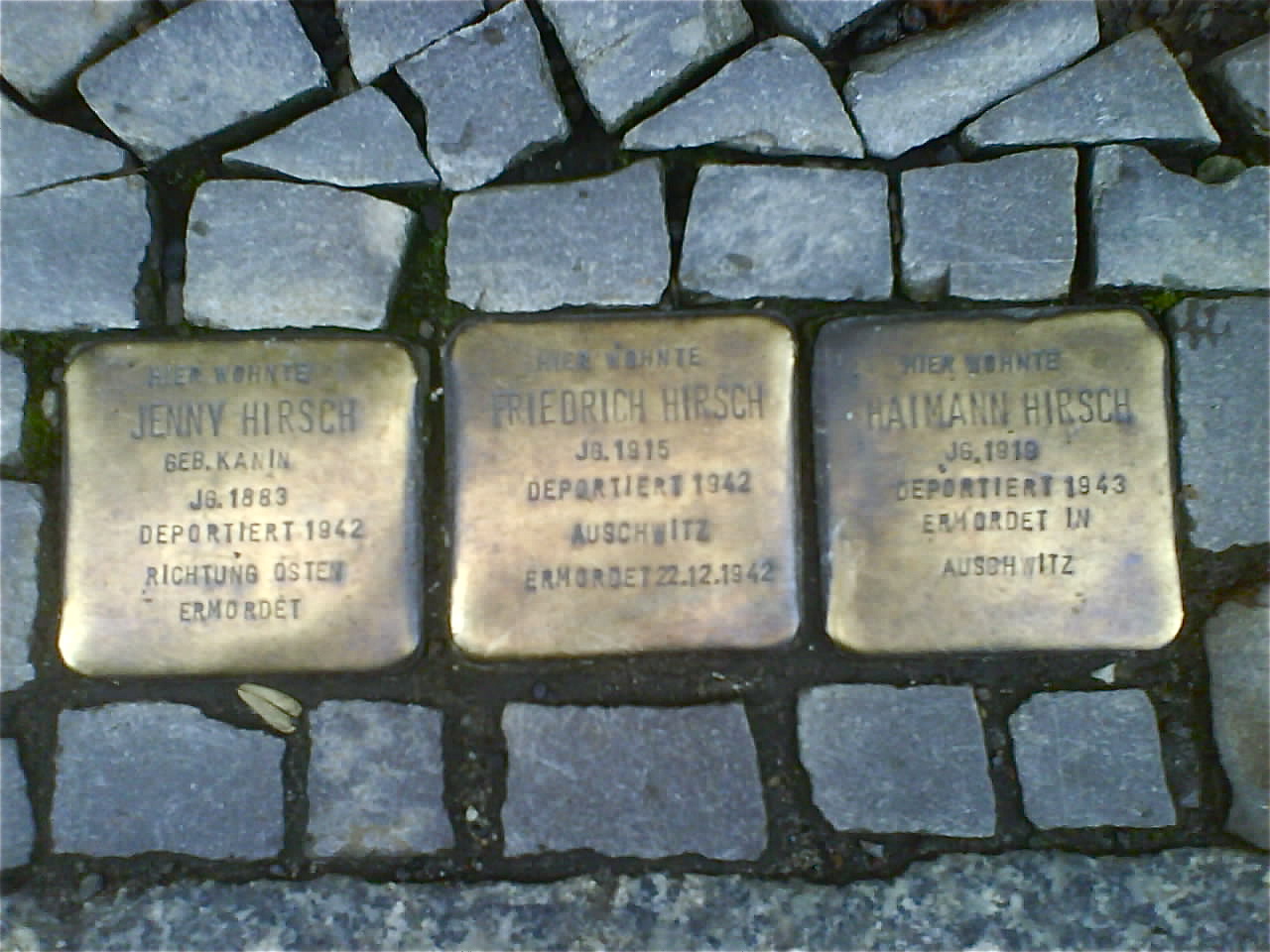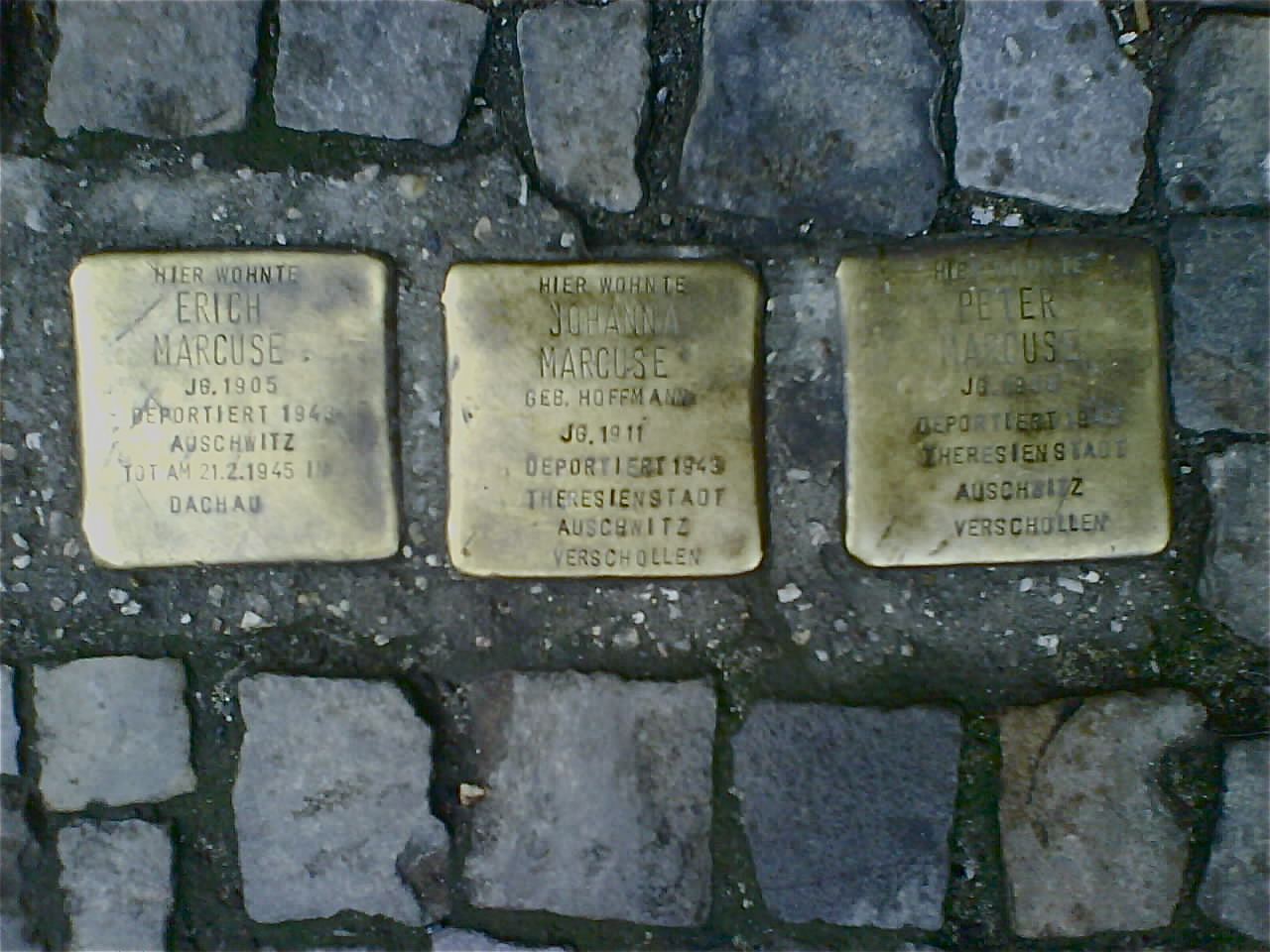So explains Gunter Demnig, the Berliner artist behind the Stolpersteine, the world‘s largest monument (in pieces) to the victims of National Socialism.
But is it really enough to know someone‘s name to conjure their memory? For someone who met the deceased, or has read something about that person, I understand how a name unlocks memory. But a stranger who stumbles across a name in the street… what does that person understand?
“Stolpern” means to trip over, to “stumble“, not just physically, but intellectually and emotionally. And so Stolpersteine are “stumbling–stones” or “stumbling blocks“. There are now almost 25 000 of them in over 500 localities, mostly in Germany but also in neighbouring countries. They measure ten centimetres by ten centimetres, which makes for a 25 square kilometre monument which is ever growing. And this scale represents only a fraction of the Nazi’s millions of victims –Jewish, Roma, Homosexual and others.
Inserted into the pavement with a hammer drill, fixed with cement matched to the surrounding pavement, slightly raised so that one can indeed stumble on them before seeing them, Stolpersteine are placed directly before the last residence of the victim. They are engraved: “Here Lived…”, followed by a name, a birth year, a year of deportation and place of death. The stones do not mince words. The victims have been “ermordet”, or “murdered“.
The Jewish community has had its doubts, as the names are trampled underfoot, but criticisms are in a minority and Demnig has been lauded with many prizes and been the subject of a documentary film. Still, not everyone wants the name of a liquidated person on their doorstep. The project had some trouble in Munich where the Stolpersteine were banned in 2004. I would think this would be a public relations disaster for a city so important to the rise of National Socialism.
Conversely, it has had much success in Berlin, where the project began in 1997: first illegally in Kreuzberg, and authorised from 2000. In some streets of the Rosenthaler Vorstadt, the old Jewish quarter in Mitte, the pavement fronting every other house is specked with brass.
But Stolpersteine are not exactly stones. They are made from metal, and look like polished heads of stakes driven into the ground. I wonder sometimes whether the name refers instead to the unmarked stones in the pavement which surround them, or those in the facades of the houses behind. It is not what is written which intrigues me, because the inscription is insufficient to conjure a person. It is the emptiness, void, lack of information, the maw of the forgotten, which gives the monuments their power and lifts them from the banality of a statistic.
And yet from the inscription, the stumbler can infer the horror.
“Here lived…” Ida and Manja Buntmann-Weinstein. Are they both women‘s names? I think so. A mother and a daughter? In 1942, one was fifty and the other was 17. They had the good sense to flee Germany to France, but were captured and interned, but held in different detention centres. Were they separated by the police? Or did one escape capture for a time? I do not think they could have travelled East together, although they were murdered in the same place. Did they see each other there, in Auschwitz, among all those millions? And did anyone in their family survive? The stones only record the victims.
And then there is the Marcuse family.
On which floor did they live? What did their neighbours do? Did they watch the Gestapo come and take them away? In the year of their deportation, 1943, Erich was 38, and (his wife?) Hannah was 32. Peter must have been their five–year old son.
Erich was separated from Hannah and Peter, and sent to Dachau where he died. The authorities kept immaculate records, so we know the exact date of his passing: 21.2.1945. Only two months later, on 29 April, Dachau was liberated by Allied troops. Hannah and Peter were sent South then East, first to Czechoslovakia, to the camp of Theresienstadt, known as Auschwitz’s “waiting room“. What happened to them in Auschwitz is unknown.
They both disappeared, like so many of the others. We do not know their fate. But that only suggests what we have lost.
10 thoughts on “Nazi Victims and Stumbling Blocks to Memory”
Comments are closed.




Beautifully written , compassionate and loving .
Being a survivor of the German atrocities I
value the humanity of the writer . His caring gives me hope for the future of mankind .A very promising writer !
We met a few months back in the apartment on Reichenberger Strasse… Today I was researching about the Stolpersteine and through google got to this post of you… can you believe the coincidence?
It's beautifully written and very touching! especially since you managed to tell a story with the few details you got from the stones. inspiring.
I think it's an amazing project.
Best,
Tal
Thanks so much, both of you!
Cheers for sharing this. Four Jewish families were lost in the town I'm living in now, Freising, and I haven't been able to find their stones yet. It's a bit disturbing to go around Germany and find Nazi eagles reinstated on new façades whilst memorials to victims are left either so vague as to be incomprehensible or hidden away.
Hi Keir,
It's also possible to sponsor a Stolperstein if you know someone who wishes to commemorate one of the families lost in Freising. I'm actually encouraged by how many visible monuments to this tragedy are present in Germany, compared to some neighboring countries!
Best wishes, Joseph
p.s. yes, I don't like the Eagle as a symbol much either, although admittedly it does predate the Nazi period
Hi Joseph,
I agree with the others that your report is very well written and informative. I was actually wondering whether you might be able to help me. I currently live in berlin and am writing a short essay on the stolpersteine in berlin for my university and I was wondering whether you might happen to know anybody living in Berlin who has purchased a stolperstein to place outside their home. It would be fantastic for my research if I could interview a few people who have bought them to ask what their motives were, how they heard about them etc etc.
Thanks for your help and best wishes,
Kerry
Hi Kerry, I will ask around for you! Best wishes, and thanks, Joseph
Dear Joseph,
I love your article, which I have quoted in a paper about German memorials. I am writing to ask whether I could have permission to use one of your images of stolpersteine in the paper, which I am submitting for publication. Please feel free to email me for further details.
Best wishes
Belinda
Dear Joseph Pearson-
I very much liked your brief essay on the stolpersteine. I wonder if you could tell me if there are any full essays in English on the subject. If there is not, there certainly should be.
I have a personal and professional interest. Four stolpersteine were just dedicated in Heidelberg to the Freunds, which include my grandparents, mother, and uncle. In 2001, I traveled with my mother to Heidelberg to participate in the city’s program for the former Jewish citizens. Subsequently, in 2002, I published an essay about our experiences in the journal, “The Public Historian.” In May, 2011, I attended the fourth Heidelberg program, this time with my 13 year old daughter. I will be speaking about this visit in my role as president of the National Council on Public History this spring and subsequently that talk will be published.
Best wishes-
Marty Blatt
This is something I really should know, but my suspicion is very little (apart from a film that came out on the subject, but of course this is not academic work). An Australian author contacted me recently about a novel which is now going to press on the subject (I will post the title when it’s available) but again, not what you are looking for. I will do some research as well. Your personal story with the Stolpersteine is very touching.